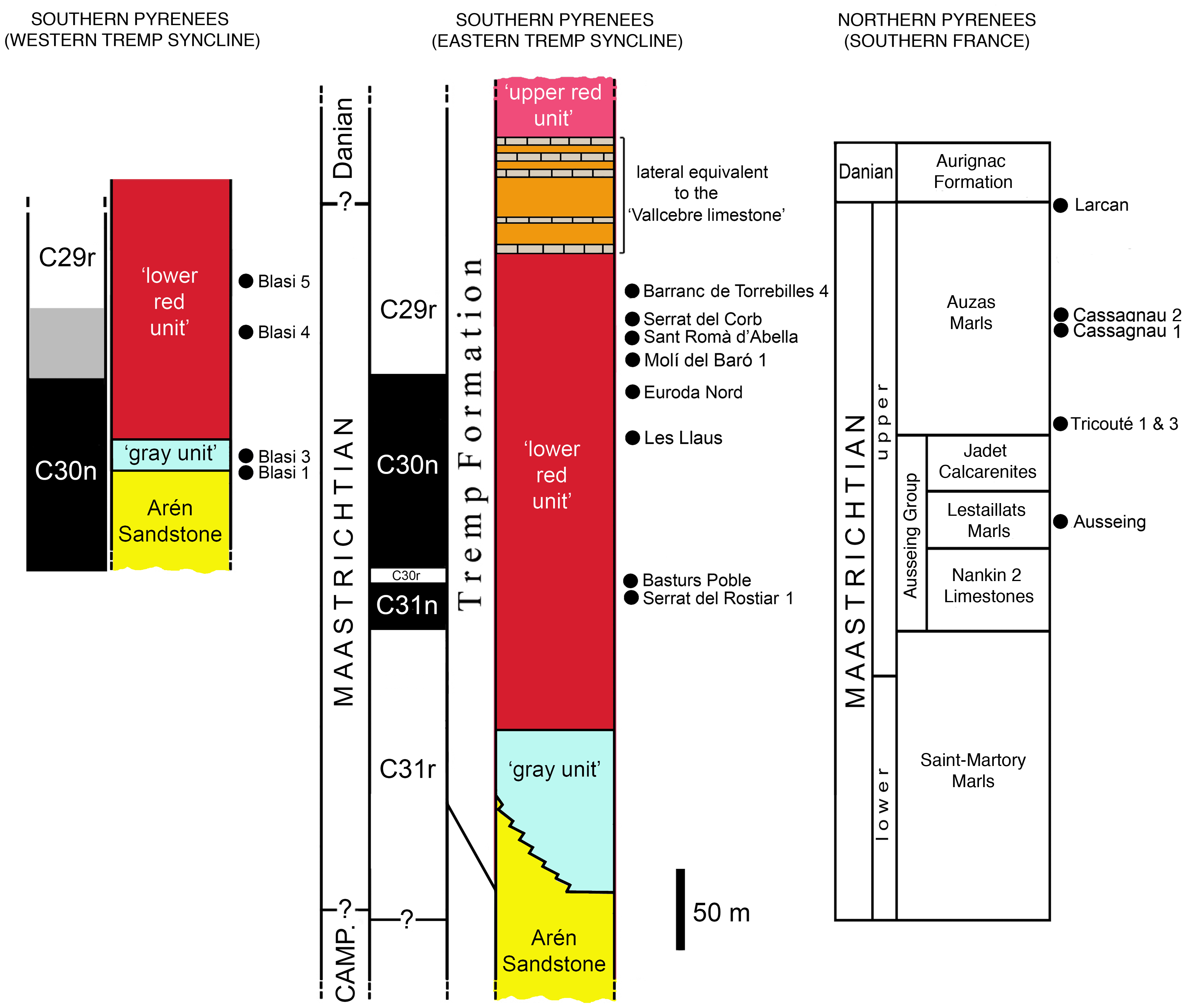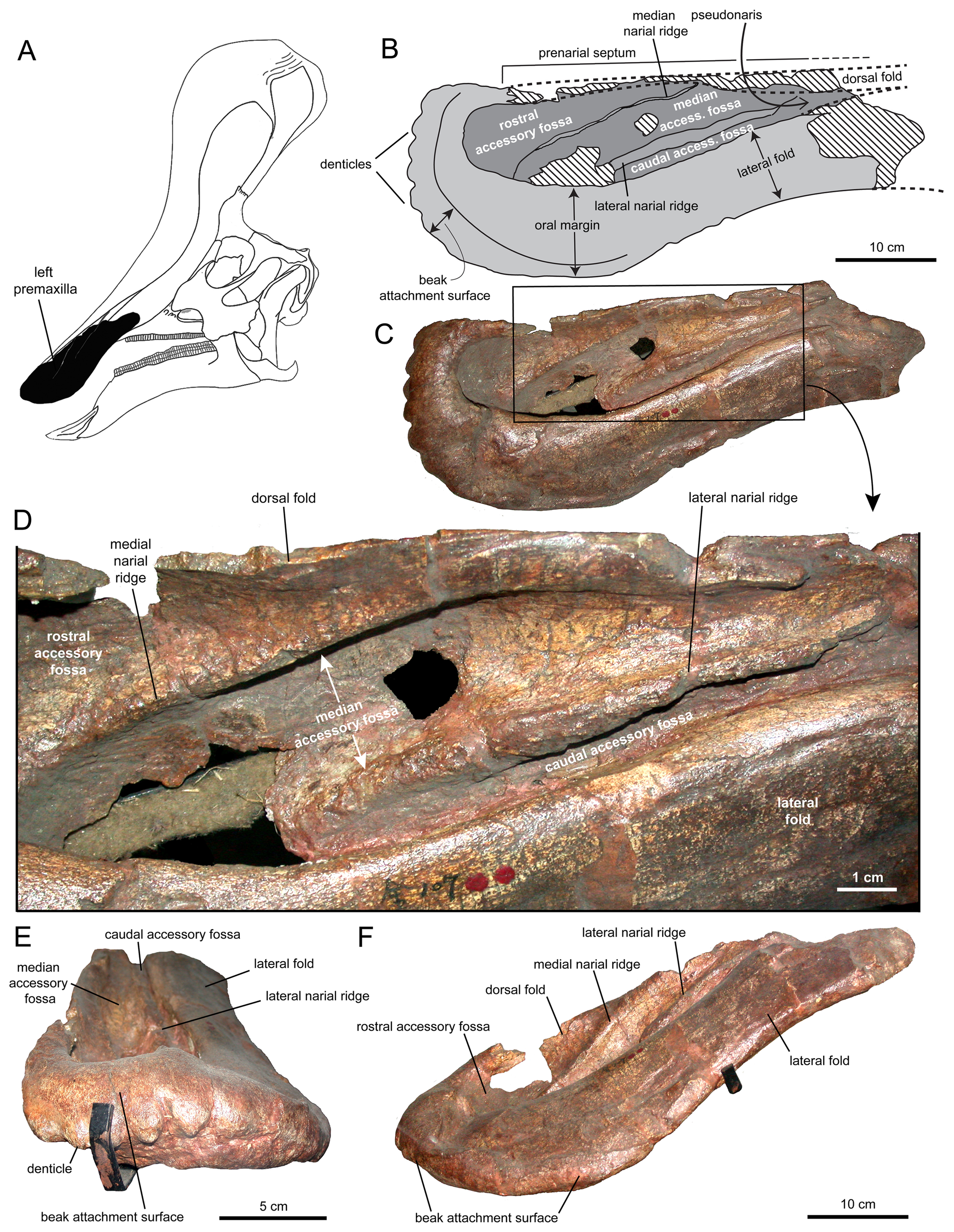|
Pararhabdodon
''Pararhabdodon'' (meaning "near fluted tooth" in reference to ''Rhabdodon'') is a genus of tsintaosaurin hadrosaurid dinosaur, from the Maastrichtian-age Upper Cretaceous Tremp Group of Spain. The first remains were discovered from the Sant Romà d’Abella fossil locality and assigned to the genus ''Rhabdodon'', and later named as the distinct species ''Pararhabdodon isonensis'' in 1993. Known material includes assorted postcranial remains, mostly vertebrae, as well as from the skull. Specimens from other sites, including remains from France, a maxilla previously considered the distinct taxon ''Koutalisaurus kohlerorum'', an additional maxilla from another locality, the material assigned to the genera ''Blasisaurus'' and ''Arenysaurus'', and the extensive Basturs Poble bonebed have been considered at different times to belong to the species, but all of these assignments have more recently been questioned. It was one of the last non-avian dinosaurs known from the fossil record th ... [...More Info...] [...Related Items...] OR: [Wikipedia] [Google] [Baidu] |
Arenysaurini
Arenysaurini is a proposed tribe of primitive lambeosaurine hadrosaurs. It is composed of genera found in Europe and North Africa during the end of the Cretaceous period, and has been suggested to unite all lambeosaurs from the former continent into a singular monophyletic group. Description Hadrosaurs were a group of herbivorous dinosaurs capable of walking on two or four legs, possessing beaks and complex batteries of teeth; members of Arenysaurini, being of the lambeosaurine lineage of Hadrosauridae, would have possessed large crests on their skulls made up of arrays of nasal passages. Multiple anatomical traits of the skull and teeth unite some or all potential members of Arenysaurini; a mixture of traits seen in primitive and derived lambeosaurs is observed. Examples of primitive traits include a short and a broad dorsal process (bony production) on the maxilla, reduced extensively in derived lambeosaurs. Additionally, several traits distinguish arenysaurs from other lambeos ... [...More Info...] [...Related Items...] OR: [Wikipedia] [Google] [Baidu] |
Tsintaosaurin
Tsintaosaurini is a tribe of basal lambeosaurine hadrosaurs native to Eurasia. It is thought to contains the genera ''Tsintaosaurus'' (from China), ''Pararhabdodon'' (from Spain) and ''Koutalisaurus'' (also from Spain), though some studies have questioned its existence as a natural grouping. Classification Tsintaosaurini is part of the family Hadrosauridae, specifically the subfamily Lambeosaurinae. The existence of a tsintaosaur clade of lambeosaurines was first recognized by palaeontologists Albert Prieto-Márquez and Johnathan R. Wagner, who in 2009 published a paper recognizing a phylogenetic relationship between ''Tsintaosaurus'' and ''Pararhabdodon'' based both on shared anatomical traits and a phylogenetic analysis. A 2013 study by Prieto-Márquez corroborated the existence of this grouping, and coined the tribe Tsintaosaurini to refer to it. The type genus is ''Tsintaosaurus'', and it was defined as the smallest clade containing ''Tsintaosaurus spinorhinus'' and ''Pararh ... [...More Info...] [...Related Items...] OR: [Wikipedia] [Google] [Baidu] |
Tsintaosaurini
Tsintaosaurini is a tribe of basal lambeosaurine hadrosaurs native to Eurasia. It is thought to contains the genera ''Tsintaosaurus'' (from China), ''Pararhabdodon'' (from Spain) and '' Koutalisaurus'' (also from Spain), though some studies have questioned its existence as a natural grouping. Classification Tsintaosaurini is part of the family Hadrosauridae, specifically the subfamily Lambeosaurinae. The existence of a tsintaosaur clade of lambeosaurines was first recognized by palaeontologists Albert Prieto-Márquez and Johnathan R. Wagner, who in 2009 published a paper recognizing a phylogenetic relationship between ''Tsintaosaurus'' and ''Pararhabdodon'' based both on shared anatomical traits and a phylogenetic analysis. A 2013 study by Prieto-Márquez corroborated the existence of this grouping, and coined the tribe Tsintaosaurini to refer to it. The type genus is ''Tsintaosaurus'', and it was defined as the smallest clade containing ''Tsintaosaurus spinorhinus'' and ''Para ... [...More Info...] [...Related Items...] OR: [Wikipedia] [Google] [Baidu] |
Tremp Group
The Tremp Formation ( es, Formación de Tremp, ca, Formació de Tremp), alternatively described as Tremp Group ( es, Grupo Tremp), is a geological formation in the comarca Pallars Jussà, Lleida, Spain. The formation is restricted to the Tremp or Tremp-Graus Basin ( ca, Conca de Tremp), a piggyback foreland basin in the Catalonian Pre-Pyrenees. The formation dates to the Maastrichtian to Thanetian,Pujalte & Schmitz, 2005, p.82 thus the formation includes the Cretaceous-Paleogene boundary that has been well studied in the area, using paleomagnetism and carbon and oxygen isotopes. The formation comprises several lithologies, from sandstone, conglomerates and shales to marls, siltstones, limestones and lignite and gypsum beds and ranges between in thickness. The Tremp Formation was deposited in a continental to marginally marine fluvial-lacustrine environment characterized by estuarine to deltaic settings. The Tremp Basin evolved into a sedimentary depression with the break-up ... [...More Info...] [...Related Items...] OR: [Wikipedia] [Google] [Baidu] |
Talarn Formation
The Tremp Formation ( es, Formación de Tremp, ca, Formació de Tremp), alternatively described as Tremp Group ( es, Grupo Tremp), is a geological formation in the comarca Pallars Jussà, Lleida, Spain. The formation is restricted to the Tremp or Tremp-Graus Basin ( ca, Conca de Tremp), a piggyback foreland basin in the Catalonian Pre-Pyrenees. The formation dates to the Maastrichtian to Thanetian,Pujalte & Schmitz, 2005, p.82 thus the formation includes the Cretaceous-Paleogene boundary that has been well studied in the area, using paleomagnetism and carbon and oxygen isotopes. The formation comprises several lithologies, from sandstone, conglomerates and shales to marls, siltstones, limestones and lignite and gypsum beds and ranges between in thickness. The Tremp Formation was deposited in a continental to marginally marine fluvial-lacustrine environment characterized by estuarine to deltaic settings. The Tremp Basin evolved into a sedimentary depression with the break-up ... [...More Info...] [...Related Items...] OR: [Wikipedia] [Google] [Baidu] |
Koutalisaurus Kohlerorum
''Koutalisaurus'' (meaning "spoon lizard", in reference to the shape of the dentary) is a potentially dubious genus of extinct hadrosaurid dinosaur from the Arenysaurini. It is based on a mostly complete dentary from the Maastrichtian-age Upper Cretaceous Tremp Formation near the town of Abella de la Conca, Lleida, Spain. Discovery and naming The holotype dentary, IPS SRA 27, had previously been referred to ''Pararhabdodon'' in 1999,Casanovas, M.L, Pereda-Suberbiola, X., Santafé, J.V., and Weishampel, D.B. (1999). First lambeosaurine hadrosaurid from Europe: palaeobiogeographical implications. ''Geological Magazine'' 136(2):205-211. but comes from a different locality, is based on non-comparable material, and has unusual characteristics, leading Prieto-Marquez ''et al.'' (2006) to place the dentary in the new species ''Koutalisaurus kohleorum''.Prieto-Marquez, A., Gaete, R., Rivas, G., Galobart, Á., and Boada, M. (2006). Hadrosauroid dinosaurs from the Late Cretaceous of Spain ... [...More Info...] [...Related Items...] OR: [Wikipedia] [Google] [Baidu] |
Tsintaosaurus
''Tsintaosaurus'' (; meaning "Qingdao lizard", after the old transliteration "Tsingtao") is a genus of hadrosaurid dinosaur from China. It was about long and weighed . The type species is ''Tsintaosaurus spinorhinus'', first described by Chinese paleontologist C. C. Young in 1958. A hadrosaur, ''Tsintaosaurus'' had a characteristic 'duck bill' snout and a battery of powerful teeth which it used to chew vegetation. It usually walked on all fours, but could rear up on its hind legs to scout for predators and flee when it spotted one. Like other hadrosaurs, ''Tsintaosaurus'' probably lived in herds. Discovery and naming In 1950, at Hsikou, near Chingkangkou, in Laiyang, Shandong, in the eastern part of China, various remains of large hadrosaurids were uncovered. In 1958 these were described by Chinese paleontologist Yang Zhongjian ("C.C. Young") as the type species ''Tsintaosaurus spinorhinus''. The generic name is derived from the city of Qingdao, earlier often transliterat ... [...More Info...] [...Related Items...] OR: [Wikipedia] [Google] [Baidu] |
Basturs Poble Bonebed
The Basturs Poble bonebed is a mega-bonebed of hadrosaur dinosaur fossils, discovered in Catalonia, Spain. Hundreds of hadrosaur fossils have been found at the site, which would have been on a large island during the Late Cretaceous when the animals preserved were alive. Despite the enormous amount of specimens, taxonomically informative material has been scarce at the site, leading to extensive debate as to its nature. The number of species present, age of the individuals present in the sample, and taxonomic identity of the remains have been the primary matters of debate. Previous considered to represent '' Koutalisaurus'', ''Pararhabdodon'', or multiple, perhaps dwarf species, it is currently thought that a single, indeterminate species of lambeosaurine was present at the site, and that individuals of many different ages were present. Discovery and extent Marc Boada discovered, in the late 1990s, a new fossil-bearing locality from the village of Basturs, Catalonia. As the villag ... [...More Info...] [...Related Items...] OR: [Wikipedia] [Google] [Baidu] |
Hadrosaurid
Hadrosaurids (), or duck-billed dinosaurs, are members of the ornithischian family Hadrosauridae. This group is known as the duck-billed dinosaurs for the flat duck-bill appearance of the bones in their snouts. The ornithopod family, which includes genera such as ''Edmontosaurus'' and '' Parasaurolophus'', was a common group of herbivores during the Late Cretaceous Period. Hadrosaurids are descendants of the Upper Jurassic/Lower Cretaceous iguanodontian dinosaurs and had a similar body layout. Hadrosaurs were among the most dominant herbivores during the Late Cretaceous in Asia and North America, and during the close of the Cretaceous several lineages dispersed into Europe, Africa, South America and Antarctica. Like other ornithischians, hadrosaurids had a predentary bone and a pubic bone which was positioned backwards in the pelvis. Unlike more primitive iguanodonts, the teeth of hadrosaurids are stacked into complex structures known as dental batteries, which acted as effectiv ... [...More Info...] [...Related Items...] OR: [Wikipedia] [Google] [Baidu] |
Lambeosaurinae
Lambeosaurinae is a group of crested hadrosaurid dinosaurs. Classification Lambeosaurines have been traditionally split into the tribes or clades Parasaurolophini (''Parasaurolophus'', ''Charonosaurus'', others (?).) and Lambeosaurini (''Corythosaurus'', ''Hypacrosaurus'', ''Lambeosaurus'', others.). Corythosaurini (synonym of Lambeosaurini, see below) and Parasaurolophini as terms entered the formal literature in Evans and Reisz's 2007 redescription of ''Lambeosaurus magnicristatus''. Corythosaurini was defined as all taxa more closely related to ''Corythosaurus casuarius'' than to ''Parasaurolophus walkeri'', and Parasaurolophini as all those taxa closer to ''P. walkeri'' than to ''C. casuarius''. In this study, ''Charonosaurus'' and ''Parasaurolophus'' are parasaurolophins, and ''Corythosaurus'', ''Hypacrosaurus'', ''Lambeosaurus'', ''Nipponosaurus'', and ''Olorotitan'' are corythosaurins. However, later researchers pointed out that due to the rules of priority set forth b ... [...More Info...] [...Related Items...] OR: [Wikipedia] [Google] [Baidu] |
1993 In Paleontology ...
Flora Plants Arthropods Insects Archosauromorphs Pseudosuchians Non-avian dinosaurs Data courtesy of George Olshevsky's dinosaur genera list. Birds Plesiosaurs References {{portal, Paleontology 1990s in paleontology Paleontology Paleontology (), also spelled palaeontology or palæontology, is the scientific study of life that existed prior to, and sometimes including, the start of the Holocene epoch (roughly 11,700 years before present). It includes the study of fossi ... [...More Info...] [...Related Items...] OR: [Wikipedia] [Google] [Baidu] |
Blasisaurus Canudoi
''Blasisaurus'' is a genus of lambeosaurine hadrosaurid dinosaur from the Late Cretaceous. It is known from a partial skull and skeleton found in late Maastrichtian-age rocks of Spain. The type species is ''Blasisaurus canudoi'', described in 2010 by Penélope Cruzado-Caballero, Xabier Pereda-Suberbiola and José Ignacio Ruiz-Omeñaca, a group of researchers from Spain. Naming and discovery The generic name refers to the ''Blasi 1'' site where the fossil was found. The specific epithet honours paleontologist José Ignacio Canudo. The holotype, MPZ99/667, is housed in Huesca. It was found in a layer of the Arén Formation dating from the upper Maastrichtian, about 66 million years ago. It consists of a skull with fragmentary lower jaws. Description ''Blasisaurus'' was a medium-sized ornithopod. Its describers identified two distinct features: the cheekbone has a rear projection with a hook-shaped upper edge and the lower sleep window is narrow and D-shaped. From the same forma ... [...More Info...] [...Related Items...] OR: [Wikipedia] [Google] [Baidu] |







